Income Elasticity of Demand
Measures how sensitive the quantity demanded of a commodity is to change in the income of the consumer
What is Income Elasticity of Demand?
The income elasticity of demand (ey) measures how sensitive the quantity demanded of a commodity is to change in the income of the consumer. It is one of the three main types of elasticity of demand, the others being the price elasticity of demand and the cross elasticity of demand.
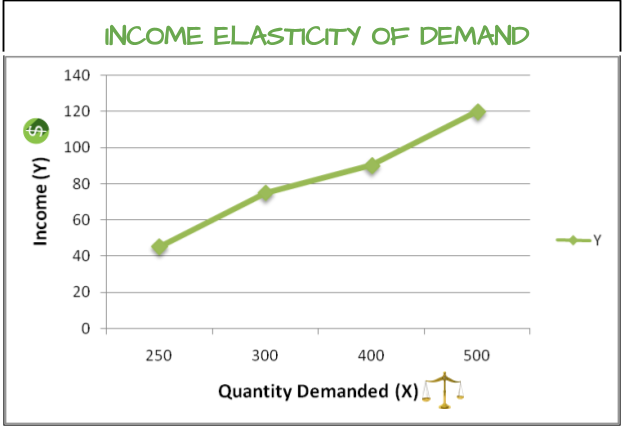
It is the degree of change in the quantity demanded of a commodity due to a change in the income of the consumer.
The elasticity of demand refers to the responsiveness degree of the demanded quality of a commodity to a change in any of its determinants like the price of the quantity, income of the consumer, price of the substitutes, etc.
There are many types of elasticity of demand as there are types of economic variables determining demand. However, the elasticity of measure is mainly categorized into the following types:
-
Price elasticity of demand
-
Income elasticity of demand
-
Cross elasticity of demand
Income elasticity is the ratio of the proportionate change in the quantity demanded of a commodity to the proportionate change in the income of the consumer.
It can be measured with the help of the following formula:
ey = Percentage change in Quantity Demanded/ Percentage change in Income
or, in symbolic terms,
ey = (𝚫Q/𝚫Y) * (Y/Q)
Where
-
eystands for income elasticity of demand
-
Y stands for initial income
-
𝚫Y stands for change in income
-
Q stands for initial quantity demanded
-
𝚫Q stands for change in quantity.
Key Takeaways
-
Income elasticity of demand(ey) is the degree of change in the quantity demanded of a commodity due to a change in the income of the consumer.
-
It is calculated by dividing the proportionate change in the quantity demanded of a commodity by the proportionate change in the income of the consumer.
-
The elasticity of demand can be broadly categorized into three types, the numerical value of which ranges from negative infinity to infinity (- ∞ < ey < ∞ ).
-
In terms of its numerical value, the three types of income elasticity are:
° Positive Income Elasticity ( 0 < ey < ∞): When the percentage (%) change in the quantity demand is greater than the percentage (%) change in the income.
° Negative Income Elasticity (- ∞ < ey < 0): When an increase in income of the consumers leads to a fall in the amount purchased of a commodity, and when a decrease in income of the consumer leads to an increase in the amount of commodity purchased.
° Zero Income Elasticity (ey = 0): When a rise in the income of the consumer does not impact the quantity demanded of that good and leaves the demand for the commodity unchanged.
Types of Income Elasticity of Demand
The percentage change in the quantity demanded of a commodity due to a change in the income of the consumers of the item may differ.
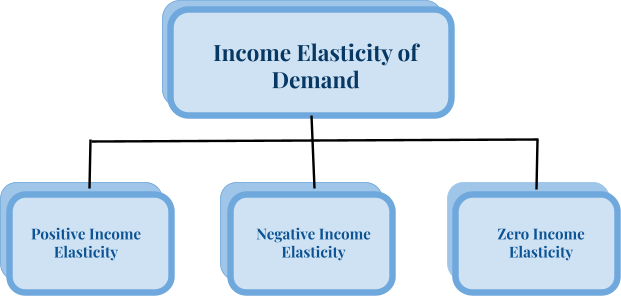
To explain this phenomenon of the degree of elasticity, economists express income elasticity in terms of its numerical value.
Thus, the income elasticity of demand may be expressed in terms of its numerical value. The numerical value ranges from negative infinity to infinity, i.e. - ∞ < ey < ∞
In terms of its numerical value, it can be broadly categorized into three types:
-
Positive Income Elasticity
-
Negative Income Elasticity
-
Zero Income Elasticity
Positive Income Elasticity
The income elasticity of demand is said to be positive when the percentage (%) change in the quantity of demand is greater than the percentage (%) change in the income.
In other words, when the amount purchased of a commodity increases due to an increase in the income of the consumers, the income elasticity is termed positive.
Similarly, when the amount purchased of a commodity decreases with a decrease in the income of the consumer, it is said to be positive elasticity of demand.
Goods with positive income elasticities are called ‘normal goods.’ For normal goods, we can classify positive income elasticity into three subcategories:
1. Income elastic: If the percentage change in quantity demanded of a commodity is greater than the percentage change in the income, i.e., 𝚫Q > 𝚫Y, then ey will exceed unity. The demand for the commodity, in this case, is said to be income elastic (ey > 1).
Generally, the luxury commodities like cars, jewelry, etc., have a high-income elasticity of demand.
2. Income inelastic: If the percentage change in quantity demanded is smaller than the percentage change in the income i.e., 𝚫Q < 𝚫Y, then ey will be less than unity. The demand for the commodity is said to be income inelastic in this case (0 < ey < 1).
Necessities like food, soap, and clothes have a low-income elasticity of demand.
3. Unitary Income Elasticity: If the percentage change in quantity demanded is equal to the percentage change in income i.e., 𝚫Q = 𝚫Y, then ey will be equal to unity. In this case, the demand for the commodity has a unit income elasticity (ey = 1).
Income elasticity of unitary represents a dividing line between income inelastic and income elastic demand.
Negative Income Elasticity
Income elasticity of demand is said to be negative when an increase in income of the consumers leads to a fall in the amount purchased of a commodity and when a decrease in income of the consumer leads to an increase in the amount of commodity purchased. (ey < 0)
This type of elasticity is mostly seen in the case of inferior goods such as frozen or canned foods, instant noodles, etc.
Less quantity is demanded at higher incomes, and high quantity is demanded at lower incomes.
For example, the income elasticity of instant noodles is negative. When income increases, consumers will switch from instant noodles to takeout or home-cooked meals with proper nutrition.
Zero Income Elasticity
Zero income elasticity of demand for a good implies that a rise in the consumer's income does not impact the quantity demanded. It leaves the demand for the commodity unchanged.
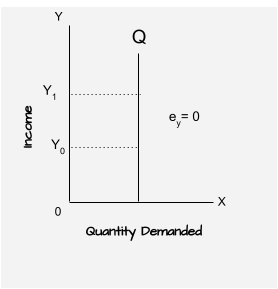
This may be possible in exceptional cases such as salt, for example. The demand elasticity for salt may be zero because an increase in the income beyond a certain level may not bring any change in the quantity of salt demanded.
The below table summarizes the description of various types of income elasticity.
Types of Income Elasticity
| Elasticity | Numerical Measure | Description |
|---|---|---|
| 1. Positive | Quantity demanded increases as the income increases. | |
| Income Inelastic | 0 < ey < 1 | Quantity demanded rises less than in proportion to income increase. |
| Unitary Income Elastic | ey = 1 | Quantity demanded rises equal in proportion to the rise in the income |
| Income Elastic | ey > 1 | Quantity demanded rises more than in proportion to income increase |
| 2. Negative | ey < 0 | Quantity demanded decreases as the income increases |
| 3. Zero | ey = 0 | Quantity demanded remains unchanged as income increases. |
asd
Example of Income Elasticity of Demand
Let's take a few examples to understand the concept better.
1. The weekly demand for shirts was observed to have increased from 5000 pieces to 7500 pieces when the level of income increased from $80 per day to $120 per day.
Calculate the income elasticity of the demand and also determine the type of income elasticity.
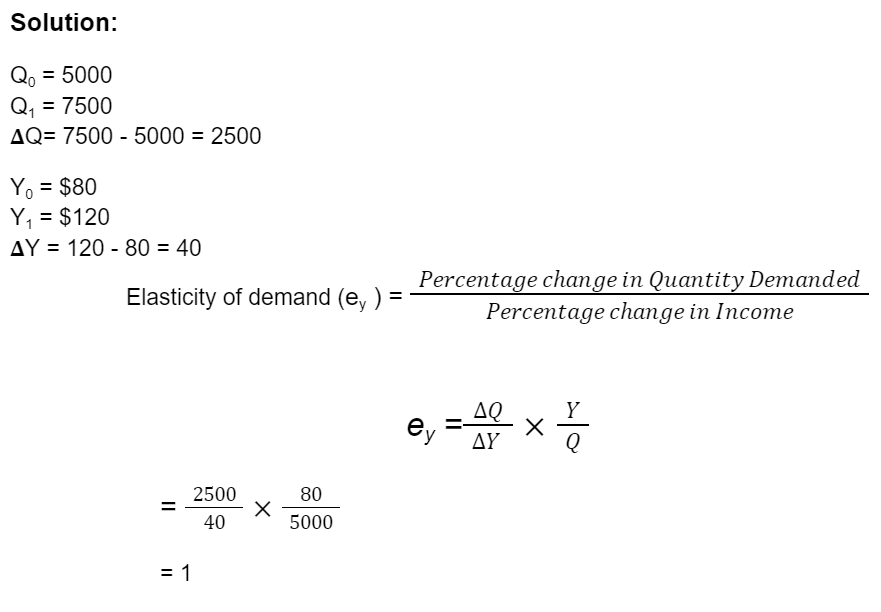
The income elasticity of demand (ey ) is unitary elastic (positive) and is equal to 1.
2. Joe's income rose from $800 to $960 per week. As a result, he purchased 8% more steak than usual. Calculate the income elasticity.
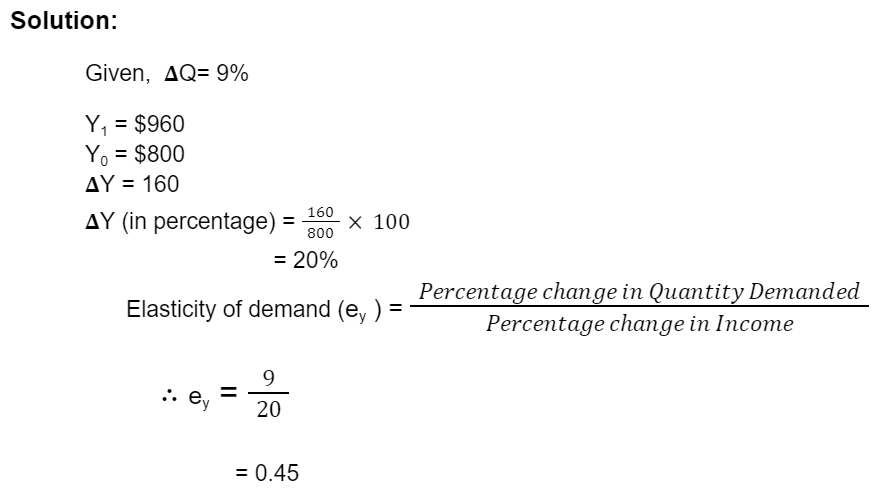
The income elasticity of demand (ey ) = 0.45 (Positive Income Inelastic).
3. The income elasticity of demand for instant noodles is -0.54, and the income increases from $45 per day to $60 per day.
Calculate the percentage change in the Quantity demanded of instant noodles. Categorize the type of goods instant noodles are. Give reasons.
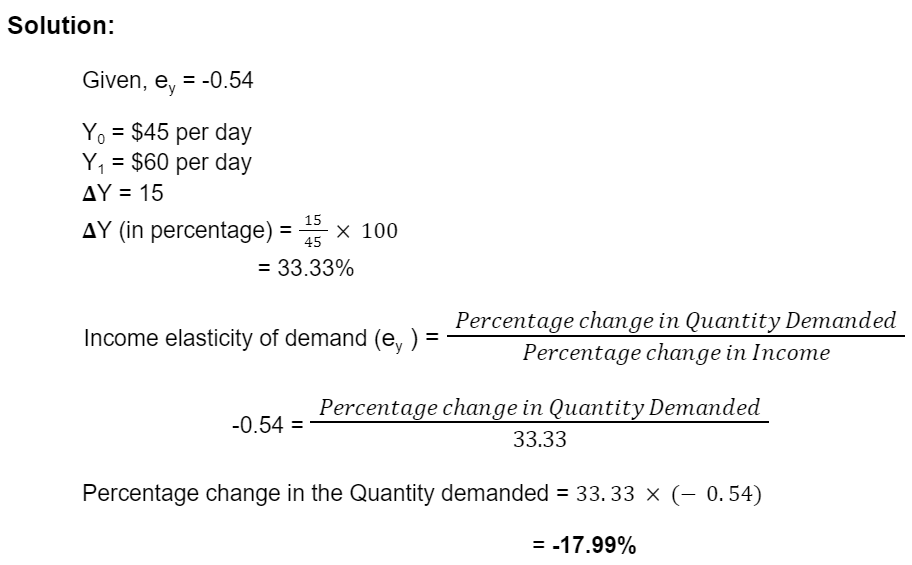
Answer: The percentage change in the Quantity demanded is (-17.99%).
Instant noodles are inferior goods as it is the demand for inferior goods that falls with an increase in income and rises with a decrease in income.
As seen in this case, instant noodles' demand fell by 17.99% due to an increase in income by 33.33%.
Importance of Elasticity of Demand
The concept of elasticity of demand is significant in various aspects of practical life. Some of the important uses of the concept of elasticity are:
1. Demand Forecasting
The elasticity of demand plays an important role in making various decisions regarding prices and output.
For example, to decide whether to increase the price of a commodity or not, the firm should be aware of the price elasticity of demand for the product. Raising the product's price will be favorable only if its demand is inelastic.
Similarly, a business enterprise should have an idea of the income elasticity of a product when determining whether or not to increase its production. In this case, additional production of those products that have a high-income elasticity is profitable.
2. Determination of Factor Prices
The elasticity of demand is important in determining the factor prices like wages. For example, the bargaining power of the trade union depends on the elasticity of demand for labor.
If the demand for labor and the demand for the product the labor is producing happens to be elastic, an attempt by the trade union to bargain wages will not succeed and vice versa.
The rise in wages will increase the price of the product and a fall in demand for the product. As a consequence, the demand for labor also falls. But if the demand for labor is inelastic, the trade unions can bargain for higher wages.
3. Incidence of Taxation
Incidence of taxes refers to the person who ultimately bears the burden of taxes. In other words, the person who ultimately pays the taxes.
To increase its revenue, the government imposes higher taxes on products with inelastic demand. However, if the government imposes higher taxes on highly elastic products, it will lead to a decline in its revenue.
The higher the elasticity of demand, the more the incidence of taxes on sellers. On the other hand, the more inelastic demand, the more the burden of taxes on the buyer.
The elasticity of demand is of great importance in making decisions regarding the terms of trade (for, the rate at which exports and imports are exchanged).
And as a result, it is also important to determine gains from international trade, the impact of exports and import duties on the imports and exports, and hence the balance of payment.
5. Rate of Exchange
The rate of exchange can be defined as the rate at which a unit of one country’s currency is exchanged for the currency of another country.
The exchange rate between two countries can be changed through devaluation or revaluation. ‘Devaluation’ is the reduction in the value of a currency, while ‘revaluation’ is the appraisal of the value of a currency.
The policy of devaluation or revaluation can be used to correct the unfavorable balance of payments. The elasticity of demand for exports and imports is considered by the government when deciding on the devaluation or revaluation of a currency.
For example, elastic demand for exports and imports will make the policy of devaluation successful.





or Want to Sign up with your social account?